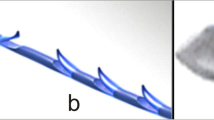Abstract
The facial area is one of the most frequently injured parts of the body (Abiose in Br J Oral Maxillofac Surg 24(1):319, 1986; Adi et al. in Br J Oral Maxillofac Surg 28(3):1949, 1990; Allan and Daly in Int J Oral Maxillofac Surg 19(5):26871, 1990), and the mandible is one of the most commonly fractured maxillofacial bones (1990; Azevedo et al. in J Trauma 45(6):10847, 1998; Bremerich et al. in Acta Stomatol Belg 93:511, 1996). Mandible is the only mobile bone of the skeleton, and hence vulnerable to fracture. This is a retrospective study of 50 mandibular fracture cases managed at the Department of ENT, Govt. Medical College Bhavnagar during the 2 years period from 2014 to 2016. Maximum subjects were in age group 21–30 years with a male preponderance. Road traffic accident is the main cause followed by falls and assault. Symphysis is the most common site of Mandibular fracture. Mandible fracture is a common entity in Road traffic accidents. Multiple fractures are seen in 40% of mandibular fracture cases. The results were equally good in patients requiring only MMF (Maxillo Mandibular Fixation) and inpatients requiring MMF and Plating, during the follow up up to 8 weeks. Physiotherapy was advised for all the post op patients after 2 months.









Similar content being viewed by others
References
Ogundare BO, Bonnick A, Bayley N (2003) Pattern of mandibular fractures in an urban major trauma center. J Oral Maxillofac Surg 61:7138
Abiose BO (1986) Maxillofacial skeleton injuries in the western states of Nigeria. Br J Oral Maxillofac Surg 24(1):319
Adi M, Ogden GR, Chisholm DM (1990) An analysis of mandibular fractures in Dundee, Scotland 1977 to 1985. Br J Oral Maxillofac Surg 28(3):1949
Allan BP, Daly CG (1990) Fractures of mandible: a 35 year retrospective study. Int J Oral Maxillofac Surg 19(5):26871
Azevedo AB, Trent RB, Ellis A (1998) Population based analysis of 10,766 hospitalizations for mandibular fractures in California 1991 to 1993. J Trauma 45(6):10847
Bremerich A, Freidl S, Gellrich NC (1996) Mandibular fractures. An epidemiological study of a 10 year cohort. Acta Stomatol Belg 93:511
Boole JR, Holtel M, Amoroso P, Yore M (2001) 5196 mandible fractures among 4381 active duty army soldiers, 1980 to 1998. Laryngoscope 111(10):16916
Kruger GO (1990) Textbook of oral and maxillofacial surgery, 6th edn. Jaypee Brothers, New Delhi
Swearingen JJ (1965) Tolerance of the human face to crash impact. Office of Aviation Medicine, Federal Aviation Agency, Stillwater
Hodgson VR (1967) Tolerance of the facial bones to impact. Am J Anat 120:113–122
Nahum AM (1975) The biomechanics of maxillofacial trauma. Clin Plast Surg 2(1):59–64
Luce EA, Tubb TD, Moore AM (1979) Review of 1000 major facial fractures and associated injuries. Plast Reconstr Surg 63(1):26–30
Huelke DF (1964) Location of mandibular fractures related to teeth and edentulous regions. J Oral Surg Anesth Hosp Dent Serv 22:396–405
Barbosa TS, Gavião MB (2008) Oral healthrelated quality of life in children: part I. How well do children know themselves? A systematic review. Int J Dent Hyg 6:939
Cortes MI, Marcenes W, Sheiham A (2002) Impact of traumatic injuries to the permanent teeth on the oral health related quality of life in 12–14 year old children. Community Dent Oral Epidemiol 30:1938
RamosJorge ML, Bosco VL, Peres MA, Nunes AC (2007) The impact of treatment of dental trauma on the quality of life of adolescents: a case control study in southern Brazil. Dent Traumatol 23:1149
Ferreira PC, Amarante JM, Silva AC, Pereira JM, Cardoso MA, Rodrigues JM (2004) Etiology and patterns of pediatric mandibular fractures in Portugal: a retrospective study of 10 years. J Craniofac Surg 15(3):38491
Haug RH, Foss J (2000) Maxillofacial injuries in the pediatric patient. Oral Surg Oral Med Oral Pathol Oral Radiol Endod 90(2):12634
Ellis E 3rd, Moos KF, elAttar A (1985) Ten years of mandibular fractures: an analysis of 2137 cases. Oral Surg Oral Med Oral Pathol 59:120–129
Olson RA, Fonseca RJ, Zeitler DL, Osbon DB (1982) Fractures of the mandible: a review of 580 cases. J Oral Maxillofac Surg 40:23–28
Adi M, Ogden GR, Chisholm DM (1990) An analysis of mandibular fractures in Dundee, Scotland (1977 to 1985). Br J Oral Maxillofac Surg 28:194–199
Bataineh AB (1998) Etiology and incidence of maxillofacial fractures in the north of Jordan. Oral Surg Oral Med Oral Pathol Oral Radiol Endod 86:31–35
Dongas P, Hall GM (2002) Mandibular fracture patterns in Tasmania, Australia. Aust Dent J 47:131–137
Luce EA, Tubb TD, Moore AM (1979) Review of 1000 major facial fractures and associated injuries. Plast Reconstr Surg 63:26–30
Imazawa T, Komuro Y, Inoue M, Yanai A (2006) Mandibular fractures treated with maxillomandibular fixation screws (MMFS method). J Craniofac Surg 17:544–549
Chuong R, Donoff RB, Guralnick WC (1983) A retrospective analysis of 327 mandibular fractures. J Oral Maxillofac Surg 41:305–309
Ogundare BO, Bonnick A, Bayley N (2003) Pattern of mandibular fractures in an urban major trauma center. J Oral Maxillofac Surg 61:713–718
Al Ahmed HE, Jaber MA, Abu Fanas SH, Karas M (2004) The pattern of maxillofacial fractures in Sharjah, United Arab Emirates: a review of 230 cases. Oral Surg Oral Med Oral Pathol Oral Radiol Endod 98:166–170
Author information
Authors and Affiliations
Corresponding author
Ethics declarations
Conflict of interest
The authors declare that they have no competing interests.
Ethical Approval
All procedures performed in studies involving human participants were in accordance with the ethical standards of the institutional and/or national research committee and with the 1964 Helsinki declaration and its later amendments or comparable ethical standards. For this type of study formal consent is not required.
Informed Consent
Informed consent was obtained from all individual participants included in the study.
Rights and permissions
About this article
Cite this article
Jha, S.G., Sinha, V., Samanth, T.U. et al. Management of Mandible Fracture by Plating and Wiring: An Otolaryngologist Perspective at Teritiary Care Center. Indian J Otolaryngol Head Neck Surg 71 (Suppl 1), 417–424 (2019). https://doi.org/10.1007/s12070-018-1332-5
Received:
Accepted:
Published:
Issue Date:
DOI: https://doi.org/10.1007/s12070-018-1332-5




